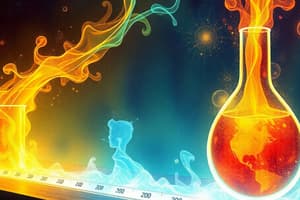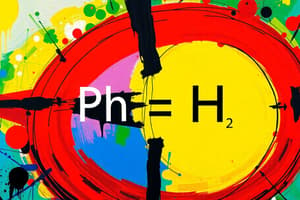Podcast
Questions and Answers
Which statement accurately describes the distinction between Arrhenius and Brønsted-Lowry bases?
Which statement accurately describes the distinction between Arrhenius and Brønsted-Lowry bases?
- Arrhenius bases donate protons, while Brønsted-Lowry bases produce hydroxide ions in water.
- Arrhenius bases are stronger than Brønsted-Lowry bases.
- Arrhenius bases are limited to aqueous solutions, while Brønsted-Lowry bases can act in non-aqueous solutions. (correct)
- Arrhenius bases accept electron pairs, while Brønsted-Lowry bases donate electron pairs.
In the following reaction, identify the conjugate acid-base pairs: $H_2O(l) + NH_3(aq) \rightleftharpoons OH^-(aq) + NH_4^+(aq)$
In the following reaction, identify the conjugate acid-base pairs: $H_2O(l) + NH_3(aq) \rightleftharpoons OH^-(aq) + NH_4^+(aq)$
- $H_2O/OH^-$ and $NH_3/NH_4^+$ (correct)
- $H_2O/H_3O^+$ and $NH_3/NH_2^-$
- $H_2O/NH_3$ and $OH^-/NH_4^+$
- $H_2O/NH_4^+$ and $NH_3/OH^-$
If a species is acting as a conjugate acid, what process is occurring?
If a species is acting as a conjugate acid, what process is occurring?
- Accepting a proton.
- Donating a proton. (correct)
- Accepting an electron.
- Donating an electron.
Which of the following expressions correctly represents the autoionization constant ($K_w$) for water at 25°C?
Which of the following expressions correctly represents the autoionization constant ($K_w$) for water at 25°C?
Which behavior exemplifies a substance acting as an amphoteric species?
Which behavior exemplifies a substance acting as an amphoteric species?
How does using $H_3O^+$ instead of $H^+$ affect the accuracy or interpretation of pH calculations in general chemistry?
How does using $H_3O^+$ instead of $H^+$ affect the accuracy or interpretation of pH calculations in general chemistry?
What is the direct relationship between the autoionization constant of water ($K_w$) and the pH scale at a given temperature?
What is the direct relationship between the autoionization constant of water ($K_w$) and the pH scale at a given temperature?
Why is calculating the pH of a solution with a strong base like $Ba(OH)_2$ different from calculating the pH of a solution with a strong base like $NaOH$?
Why is calculating the pH of a solution with a strong base like $Ba(OH)_2$ different from calculating the pH of a solution with a strong base like $NaOH$?
Which characteristic accurately describes the behavior of strong acids in aqueous solutions?
Which characteristic accurately describes the behavior of strong acids in aqueous solutions?
Which of the following is NOT a strong acid?
Which of the following is NOT a strong acid?
What is a key factor in determining whether a base is considered strong?
What is a key factor in determining whether a base is considered strong?
What is the significance of the 'p' in terms like pH and pOH?
What is the significance of the 'p' in terms like pH and pOH?
Why is the pH calculation for a weak acid different from that of a strong acid with identical concentrations?
Why is the pH calculation for a weak acid different from that of a strong acid with identical concentrations?
Given the weak acid $HA$ in water, which expression correctly represents the equilibrium constant ($K_a$)?
Given the weak acid $HA$ in water, which expression correctly represents the equilibrium constant ($K_a$)?
When determining the pH of a weak acid solution, what initial information and tools are essential for an ICE table calculation?
When determining the pH of a weak acid solution, what initial information and tools are essential for an ICE table calculation?
What is one of the 'flavors' of ICE chart problems for acids or bases?
What is one of the 'flavors' of ICE chart problems for acids or bases?
If an acid has a high $K_a$ value, what can be inferred about the strength of its conjugate base?
If an acid has a high $K_a$ value, what can be inferred about the strength of its conjugate base?
How does the strength of a strong acid or base influence the acid-base properties of its conjugate?
How does the strength of a strong acid or base influence the acid-base properties of its conjugate?
From the options below, select the acid that is classified as diprotic.
From the options below, select the acid that is classified as diprotic.
What is the main factor that determines whether a salt solution will be acidic, basic, or neutral?
What is the main factor that determines whether a salt solution will be acidic, basic, or neutral?
How does the presence of a strong acid affect the contribution of a weak acid to the overall pH of a solution containing both?
How does the presence of a strong acid affect the contribution of a weak acid to the overall pH of a solution containing both?
What is the effect on pH when ammonium chloride ($NH_4Cl$) dissolves in water, and how does hydrolysis contribute to this effect?
What is the effect on pH when ammonium chloride ($NH_4Cl$) dissolves in water, and how does hydrolysis contribute to this effect?
How does the Lewis definition of acids and bases broaden the scope compared to the Arrhenius definition?
How does the Lewis definition of acids and bases broaden the scope compared to the Arrhenius definition?
How is the Arrhenius definition of acids and bases related to the Lewis definition?
How is the Arrhenius definition of acids and bases related to the Lewis definition?
For a conjugate acid-base pair, $HX$ and $X^-$, which equation correctly relates their respective equilibrium constants $K_a$ and $K_b$ to the autoionization constant of water ($K_w$) at a given temperature?
For a conjugate acid-base pair, $HX$ and $X^-$, which equation correctly relates their respective equilibrium constants $K_a$ and $K_b$ to the autoionization constant of water ($K_w$) at a given temperature?
A solution contains both a strong acid and a weak acid. The strong acid has a concentration of 0.1 M, and the weak acid has a $K_a$ of $1.0 \times 10^{-5}$. Which best describes how the strong acid suppresses the ionization of the weak acid?
A solution contains both a strong acid and a weak acid. The strong acid has a concentration of 0.1 M, and the weak acid has a $K_a$ of $1.0 \times 10^{-5}$. Which best describes how the strong acid suppresses the ionization of the weak acid?
Consider the dissolution of sodium acetate ($NaC_2H_3O_2$) in water. Sodium acetate is the salt of a strong base ($NaOH$) and a weak acid ($CH_3COOH$). What effect does the acetate ion have on the pH of the solution, and through what mechanism does it alter the pH?
Consider the dissolution of sodium acetate ($NaC_2H_3O_2$) in water. Sodium acetate is the salt of a strong base ($NaOH$) and a weak acid ($CH_3COOH$). What effect does the acetate ion have on the pH of the solution, and through what mechanism does it alter the pH?
Predict which of the following salts will form a basic solution when dissolved in water?
Predict which of the following salts will form a basic solution when dissolved in water?
Flashcards
Arrhenius acids and bases?
Arrhenius acids and bases?
Arrhenius acids produce H+ ions in water, and Arrhenius bases produce OH- ions in water.
Brønsted-Lowry acids and bases?
Brønsted-Lowry acids and bases?
Acids are proton (H+) donors, and bases are proton acceptors.
Conjugate acid-base pair?
Conjugate acid-base pair?
Pair of compounds differing by one proton (H+).
Conjugate base/acid of NH3?
Conjugate base/acid of NH3?
Signup and view all the flashcards
Autoionization of water?
Autoionization of water?
Signup and view all the flashcards
Amphoteric substance?
Amphoteric substance?
Signup and view all the flashcards
What is H+?
What is H+?
Signup and view all the flashcards
Kw and the pH scale?
Kw and the pH scale?
Signup and view all the flashcards
How to calculate pH?
How to calculate pH?
Signup and view all the flashcards
The 7 strong acids?
The 7 strong acids?
Signup and view all the flashcards
How to identify a strong base?
How to identify a strong base?
Signup and view all the flashcards
What does the ‘p' mean in chemistry?
What does the ‘p' mean in chemistry?
Signup and view all the flashcards
Weak acid or base mean?
Weak acid or base mean?
Signup and view all the flashcards
Equilibrium expression for weak acid/base?
Equilibrium expression for weak acid/base?
Signup and view all the flashcards
Strengths of acids and bases related?
Strengths of acids and bases related?
Signup and view all the flashcards
Diprotic acid?
Diprotic acid?
Signup and view all the flashcards
Factors determining if salt acidic, basic, or neutral?
Factors determining if salt acidic, basic, or neutral?
Signup and view all the flashcards
Lewis acids and bases?
Lewis acids and bases?
Signup and view all the flashcards
Study Notes
Introduction to Acids, Bases, and pH
- Arrhenius acids produce H⁺ ions in water
- Arrhenius bases produce OH⁻ ions in water
- Bronsted-Lowry acids are proton donors
- Bronsted-Lowry bases are proton acceptors
- A conjugate acid-base pair contains two substances differing by one proton (H⁺)
- HF and F⁻ form a conjugate acid-base pair
- HF donates a proton to become F⁻, and F⁻ accepts a proton to become HF
- The conjugate base for NH₃ is NH₂⁻
- The conjugate acid for NH₃ is NH₄⁺
- When writing the conjugate base, the initial species acts as an acid by donating a proton
- When writing the conjugate acid, the initial species acts as a base by accepting a proton
- The autoionization of water equation is: H₂O(l) + H₂O(l) ⇌ H₃O⁺(aq) + OH⁻(aq)
- The expression for Kw is: Kw = [H₃O⁺][OH⁻] = 1.0 × 10⁻¹⁴ at 25°C
- Kw is derived from the equilibrium constant expression for water's autoionization
- Amphoteric substances can act as both an acid and a base
- Water (H₂O) is amphoteric because it can both donate and accept a proton
- H⁺ is a proton, and H₃O⁺ is a hydronium ion
- H⁺ and H₃O⁺ are often interchangeable when describing hydrogen ions in solution
- Kw is the product of [H₃O⁺] and [OH⁻] in water
- The pH scale is based on [H₃O⁺]
- As [H₃O⁺] increases, pH decreases
- As [H₃O⁺] decreases, pH increases
- A neutral solution has a pH of 7, where [H₃O⁺] = [OH⁻]
- The pH scale is technically accurate at 25°C
- An acidic solution has a pH less than 7
- A basic solution has a pH greater than 7
pH Calculation for Strong Acids and Bases
- Strong acids 100% dissociate, producing H⁺ ions
- pH of a strong acid can be found by: -log[strong acid concentration]
- Strong bases don't always have a direct concentration to [OH⁻] relationship
- pOH = -log[OH⁻]
- pH = 14 – pOH
Strong Acids and Bases
- The 7 strong acids: HCl, HBr, HI, HNO₃, HClO₄, H₂SO₄, HClO₃
- Strong bases completely dissociate in water and produce HO⁻ ions
- Common strong bases include Group 1 metal hydroxides, and some Group 2 metal hydroxides
pH and pOH relationship
- The 'p' function means "the negative logarithm of" in chemistry
- pH = -log[H⁺], pOH = -log[OH⁻]
Weak Acids and Bases
- Weak acids/bases only partially dissociate in water
- Weak acids/bases are less effective at donating or accepting protons vs. strong acids/bases
- The dissociation of HCl is 100%, weak acids/bases dissociate less
- Equilibrium expression for weak acid: Ka = [H₃O⁺][A⁻] / [HA], for HA + H₂O ⇌ H₃O⁺ + A⁻
- Equilibrium expression weak base: Kb = [BH⁺][OH⁻] / [B], for B + H₂O ⇌ BH⁺ + OH⁻
Calculating pH of Weak Acids/Bases
- pH of weak acids/bases is calculated using the equilibrium expression (Ka or Kb) and an ICE table
- Need to find the equilibrium concentrations of hydronium or hydroxide, depending on if it is an acid or base
- Strong acids/bases fully dissociate, allowing pH calculation from initial concentrations directly
ICE Charts
- For weak acids: acid + water ⇌ hydronium ion + conjugate base
- For weak bases: base + water ⇌ hydroxide ion + conjugate acid
ICE Chart Problems
- ICE charts can be used to solve for a missing initial or equilibrium concentration using the equilibrium constant, which can then be used to find pH
- ICE charts can be used to find the equilibrium constant using the pH and concentrations to complete the ICE table
- When using ICE charts, you can use the approximation in chapter 16 to make solving any quadratic equations quicker
Acid/Base Strength and Conjugates
- The stronger an acid, the weaker its conjugate base
- The stronger a base, the weaker its conjugate acid
- Strong acid/base conjugates are so weak they have no acid/base properties
- For conjugate acid-base pairs: Kw = Ka × Kb
- If an acid has a high Ka, its conjugate base will have a low Kb, and vice versa
Diprotic and Polyprotic Acids
- Diprotic acids donate two protons (H⁺), like H₂SO₄
- Polyprotic acids donate more than one proton, like H₃PO₄ (three protons)
- HF is monoprotic (one proton)
Salt Solutions
- pH of a salt solution depends on strength of the acid and base it's made from
- Salt from a strong acid and weak base: acidic solution
- Salt from a weak acid and strong base: basic solution
- Salt from a strong acid and strong base: neutral solution
- Break the salt into its component ions to determine each ion's strength
- Conjugates of strong acids/bases are considered so weak, they can be considered neutral
pH of Strong and Weak Acid Solutions
- In a solution of a strong acid and a weak acid, calculate pH using the strong acid concentration
- Need to determine the concentration of hydronium ions
- The amount of hydronium produced from a weak acid is so small compared to a strong acid, it can be ignored
Salt Hydrolysis
- Salt hydrolysis happens when a salt like ammonium chloride (NH₄Cl) dissolves in water
- NH₄Cl (s) → NH₄⁺ (aq) + Cl⁻ (aq)
- NH₄⁺ acts as a weak acid and donates a proton to water: NH₄⁺ (aq) + H₂O (l) ⇌ NH₃ (aq) + H₃O⁺ (aq)
- Cl⁻ doesn't affect pH because it comes from a strong acid (HCl) and doesn't react with water
Lewis Acids and Bases
- Lewis acid: substance that accepts a pair of electrons
- Lewis base: substance that donates a pair of electrons
- Arrhenius definition is the most specific, Lewis definition is the broadest
- All Arrhenius acids are Lewis acids, but not all Lewis acids are Arrhenius acids
Studying That Suits You
Use AI to generate personalized quizzes and flashcards to suit your learning preferences.




